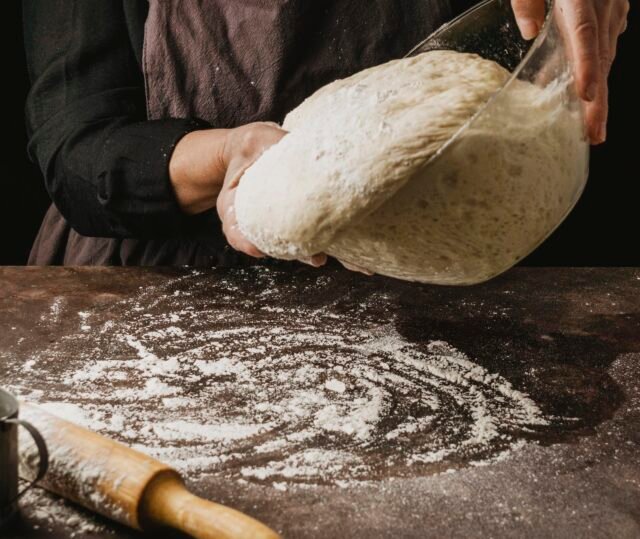In professional baking, the dough is more than a mix of flour, water, salt, and yeast. It’s the foundation of a product that must consistently meet quality expectations, support high-volume production, and maintain its character even after extended storage or transport. To meet these demands, many commercial bakers and chefs turn to modern baking additives designed to enhance elasticity, handling, and shelf life—without changing the core nature of traditional dough-making.
This article explores how these smart ingredients work, especially in the context of pizza production, where dough performance is critical from prep to plate.
What Is Dough Elasticity, and Why Does It Matter?
Dough elasticity refers to the dough’s ability to return to its original shape after being stretched. It’s a function of gluten strength and structure, directly affecting:
- The ease of shaping and sheeting
- The ability to retain gas during fermentation
- The final crust’s texture and visual appeal
In pizza production, elasticity determines how well the dough holds shape during tossing or pressing, and whether it forms an airy, chewy base or a dense, uneven one.
Shelf Life in the Baking Industry: Beyond Just Freshness
Shelf life doesn’t only refer to how long a dough or crust remains edible—it’s also about:
- Retaining flexibility post-bake
- Delaying staling
- Preserving taste and structure after storage or reheating
For chefs and production managers, this is a logistical advantage. A pizza that remains crisp outside and soft inside even after sitting under a heat lamp or passing through delivery channels offers clear commercial value.
What Are Pizza Dough Conditioners?
A Pizza Dough Conditioner is a targeted additive blend that helps regulate dough elasticity, fermentation strength, and post-bake softness. It’s not a shortcut—it’s a controlled enhancer designed for large-scale or high-consistency baking systems.
Depending on formulation, a dough conditioner may include:
- Enzymes to optimize gluten functionality
- Oxidizing agents for stronger gluten bonding
- Moisture regulators that help control internal water balance
Each component serves a functional role, either improving dough handling or extending the usable life of the product without changing its core ingredients.
Advantages of Using Dough Conditioners in Pizza Production
Let’s break down what benefits a dough conditioner offers to professionals:
1. Enhanced Stretch and Recovery
The dough stretches easily and returns without tearing—ideal for hand-tossing or automated sheeting.
2. Faster and More Predictable Proofing
Fermentation becomes more consistent, minimizing over- or under-proofed batches.
3. Longer Shelf Stability
From cold storage to hot-hold stations, the final crust maintains texture and chew for longer periods.
4. Adaptability to Environment
In varying humidity, flour quality, or temperature conditions, dough conditioners stabilize behavior and reduce manual correction.
Practical Application: How to Incorporate Additives
Integrating modern additives into your process requires accuracy and observation. Here are key points for smooth implementation:
- Weigh accurately: Use digital scales for each batch to maintain consistency.
- Mix thoroughly: Ensure complete distribution in the mixing phase.
- Record adjustments: Keep track of behavior changes to optimize future batches.
- Trial on a small scale: Before introducing into full production, test small batches and tweak based on performance.
Real-World Scenarios Where Conditioners Help
Case 1: Pre-formed Pizza Bases for Storage
In commissary-style operations or cold-chain logistics, dough needs to retain pliability after thawing or pre-baking. Conditioners ensure that even after extended storage, the product performs well during baking and serving.
Case 2: High-Speed Production Environments
When producing thousands of dough balls per shift, even slight resistance or tearing can slow down assembly lines. A well-formulated Pizza Dough Conditioner supports fast handling without compromising dough quality.
Considerations for Choosing the Right Additive
Not all dough systems are the same. When selecting a conditioner:
- Match it to your process: Some blends are ideal for long-ferment doughs; others are better for quick-bake applications.
- Avoid overuse: Excessive quantities can cause undesired texture changes.
- Stay label-compliant: Ensure all ingredients align with your production region’s food safety and labeling regulations.
Balancing Tradition and Technology
Using additives doesn’t mean compromising craftsmanship. In fact, for many artisan-style operations scaling up production, these tools help maintain hand-crafted quality at higher volumes. The goal is to support—not replace—the principles of fermentation, gluten development, and flavor formation that define great pizza.
With the right Pizza Dough Conditioner, operations become more agile, predictable, and profitable—without altering the authenticity of the final product.
Conclusion: Moving Forward with Precision and Confidence
Modern baking is rooted in innovation, not compromise. Dough conditioners are a reflection of that mindset—designed for chefs who want better control over product performance while respecting the heritage of quality baking.
By improving elasticity and extending shelf life, baking additives solve real-world challenges without taking away from the artistry of dough making. Whether you manage a central production facility or operate within a high-throughput culinary setup, investing in the right additive strategy brings both operational efficiency and consistent results to your process.







[…] Enhancing Dough Performance: Smart Solutions for Consistent, Artisan-Quality Pizza Crusts […]